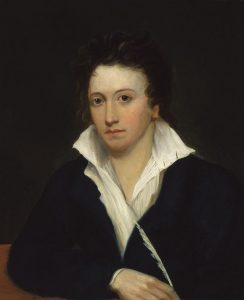45 Biography: Percy Bysshe Shelley

Portrait of Percy Bysshe Shelley
Artist | Alfred Clint Source | Wikimedia Commons License | Public Domain
(1792-1822)
Percy Bysshe Shelley was probably the most intellectual of all the Romantic poets; he was certainly one of the most well-educated. He was a non-conformist thinker, a philosopher, and rebel. All of these characteristics join in his theory of poetry and poetic output, with their commitment to radical politics and their visionary idealism influenced by Platonism. Like Byron, Shelley was born into an aristocratic family, was in line to inherit a large estate, and was secured of a seat in the House of Lords in Parliament. Instead, Shelley became the river that made its own banks.
This independence of both thought and action appeared when Shelley wrote a pamphlet On the Necessity of Atheism while at Oxford. Rather than leading to intellectual debate as he expected, this pamphlet led to his being expelled. At the age of nineteen, Shelley eloped with Harriet Westbrook, the daughter of a stable hand. He pursued his intellectual and political interests by befriending the socialist philosopher William Godwin (1756-1836) and publishing Queen Mab, a utopian poem. At the grave of Godwin’s deceased wife Mary Wollstonecraft, Shelley also wooed their daughter Mary Wollstonecraft Godwin. The two eloped to Europe, Shelley’s wife Harriet having refused to join them. In 1816, Harriet Shelley committed suicide by drowning herself in the shallow end of the Serpentine River; she was apparently pregnant with another man’s child. Mary Godwin and Percy Bysshe had lost two children of their own before they married upon Harriet’s death. Percy Bysshe lost custody of his and Harriet’s two children due to his reputation.
Percy Bysshe and Mary Shelley traveled throughout Italy where Percy Bysshe wrote the bulk of his most famous works. In 1822, he drowned while sailing his schooner Don Juan (named after a poem by Byron) from Livorno to Lerici. He may have desired this death, disappointed and disaffected with the “triumph of life” over vision. He certainly seems to have predicted this mode of death in Adonais, an elegy he wrote for John Keats: “My spirit’s bark is driven,/ Far from the shore, far from the trembling throng/ Whose sails were never to the tempest given” (489-91).
It is important to consider the breadth and height of Shelley’s demands on poetry. He had great expectations from poetry and from poets, whom he described as power figures; for poets channel the power of the source itself (rather than the dominion). He therefore presents poets as the channels of power for change, for freedom, for humanity. His The Defense of Poetry takes the challenge Plato made when ejecting poets from his Republic. In it, Shelley describes poets as the best men with the best thoughts who see the seeds of the future cast upon the present. As such, they are the “unacknowledged legislators of the world.”
This material is from British Literature II: Romantic Era to the Twentieth Century and Beyond by Bonnie J. Robinson from the University System of Georgia, which is licensed under a Creative Commons Attribution-ShareAlike 4.0 International License.
This license allows you to remix, tweak, and build upon this work, even commercially, as long as you credit this original source for the creation and license the new creation under identical terms.
